provided by John E. Phillips
Jerry Clinton, or “Skeeter” as he’s known to family and friends, lives in Oliver Springs, Tennessee. He has been a Mossy Oak ProStaffer for the last three years and is a chapter president of Milton Hill Longbeards of the National Wild Turkey Foundation (NWTF). He is on Tennessee’s board of directors for the NWTF. Learn how Skeeter got his hate on for hogs, how and why he takes them all year long, and what he does with the hogs he takes.
Skeeter Hates Hogs Partly Because He Loves Turkeys
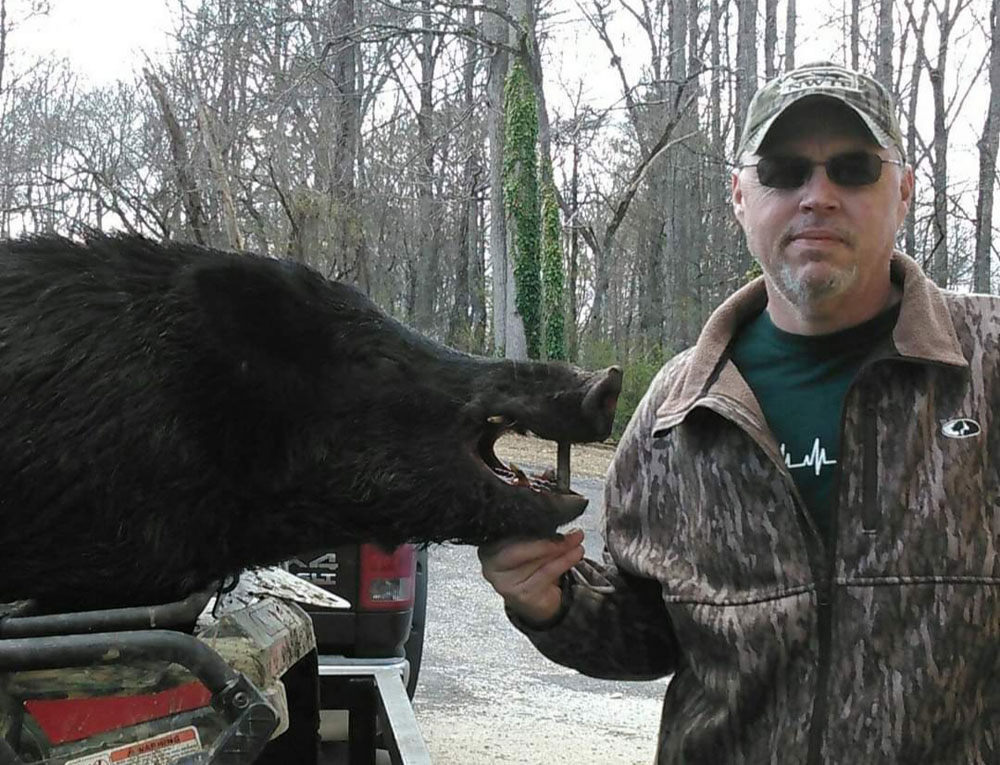
I’ve been hunting wild hogs for about 18 years. In the beginning, hog hunting was just another kind of hunting I could do before and after turkey season and deer season. Also, in the past, we could hunt hogs here in Tennessee when all the other seasons were closed. I pretty much hunted wild hogs all year long. I’ve hunted hogs from tree stands, with dogs, stalk hunted them around creek beds and driven them out of laurel thickets to standers. When standing, two or three of us would bust through a laurel thicket on the edge of a creek bank, whooping and hollering to spook the hogs out of the thicket. Most of the time, the standers would shoot those feral pigs when they ran out of the thickets. The most hogs we ever got out of a laurel thicket was 14 in one day, but we’d average getting five or six most days.
Feral hogs are the most destructive critters in the woods, but my main reason I hate the porkers is because they break up turkey nests and eat turkey eggs. If I can pick only one type of hunting that I can participate in for the rest of my life, turkey hunting is my choice. For that reason, anytime I can shoot a hog of any size, I feel like I’m saving one or two turkey nests that will produce more turkeys for me and my friends to enjoy hunting.
I don’t hunt hogs very much in the summertime, unless one of my neighbors calls me and has a problem with hogs destroying his crop. If the neighbor lives close to me, I can take the hogs I shoot, get them back to my house, field dress them and put them in my walk-in cooler, until I have time to skin them, butcher them and put the meat in my freezer. However, if a farmer lives more than two hours away from my house, we just leave the dead hogs for the predators. The way I was raised, my parents taught me, “If you kill it, you eat it.” But when the air temperature is 90-100 degrees, I’ve learned that a hog’s meat will spoil if I can’t get it to a cooler within two hours.
Wild hogs are a terrible problem for our farmers and neighbors in this part of Tennessee. When a game warden calls me and asks me to help a farmer get rid of some hogs destroying his crops, I go to wherever the farmer lives and help him solve that problem. I have nuisance permits to take hogs at any time of the year when a farmer or a game warden calls me to stop the hogs from destroying agricultural crops.
Wild Hog Problems Can Be Solved by Trapping
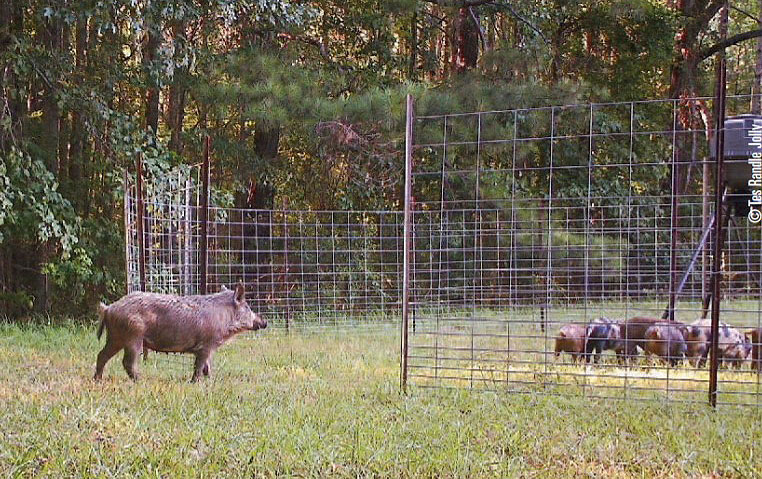
Since I have a nuisance permit to hunt on several different properties, I can hunt wild hogs all year long during the daytime or the nighttime. I can hunt hogs over bait, I can trap them, or I can use whatever means I have to stop the hogs from damaging a landowner’s property and/or his crops.
I was called in to help a farmer from Jamestown, Tenn., that had 200 acres of corn. He was able to claim the total crop as a loss because a large group of hogs moved onto his land and destroyed and ate his crop. Most of the time, landowners will call me to help solve their hog problems. I also have quite a few friends who work for the Tennessee Wildlife Resource Agency - TWRA. When they get a call from a landowner with a hog problem, they’ll give that landowner my phone number. I’ll go out and do what I have to do to take care of the hog problem. Often when I get a call during the summertime, I’ll go to a farmer and sit on the edges of his agricultural fields and start shooting hogs. I don’t really like to hunt wild hogs after dark, because we’ve got some rattlesnakes up in these mountains where I live that are as big around as my leg. I’d just as soon not walk across one of those snakes in the dark.
If the feral-pig problem isn’t too severe, I’ve also got traps I can set to catch the hogs. I’ve got corral traps and portable box traps. I can take those box traps and place them anywhere in the woods or along the field edges where I can drive my four-wheeler. Right now, I have two corral traps and several 4 foot by 6 foot portable traps. I have two tires on one end of each trap, and a trailer hitch on the other end of each trap. I can pull those portable traps anywhere I need them to be to catch hogs. In my portable traps, I may catch 12 to 13 shoats (young hogs) weighting 15 to 20 pounds. I’ve caught as many as four, 80 to 90-pound hogs in each of those traps at a time. The most I’ve ever caught in my corral trap at one time was 36 hogs.
The TWRA requires me to kill the hogs on the spot when I catch them, and I can’t transport any live hogs from the traps where they are caught. If the air temperature is less than 80 degrees, I’ll load the hogs up and bring them home. If I can get those hogs we catch in our traps home quickly and field dress, skin and put them in the cooler, plenty of folks around here need some food to eat. Since I have an 8x10 foot cooler, I can save much of that meat to give to my family, friends and neighbors. The most I’ve ever had in my cooler at one time was the night we had 36 in the trap. Most of those pigs were young pigs, so I had plenty of room in the cooler to hold the meat for several days.
Skeeter Clinton Defines What’s an Eating Size Hog
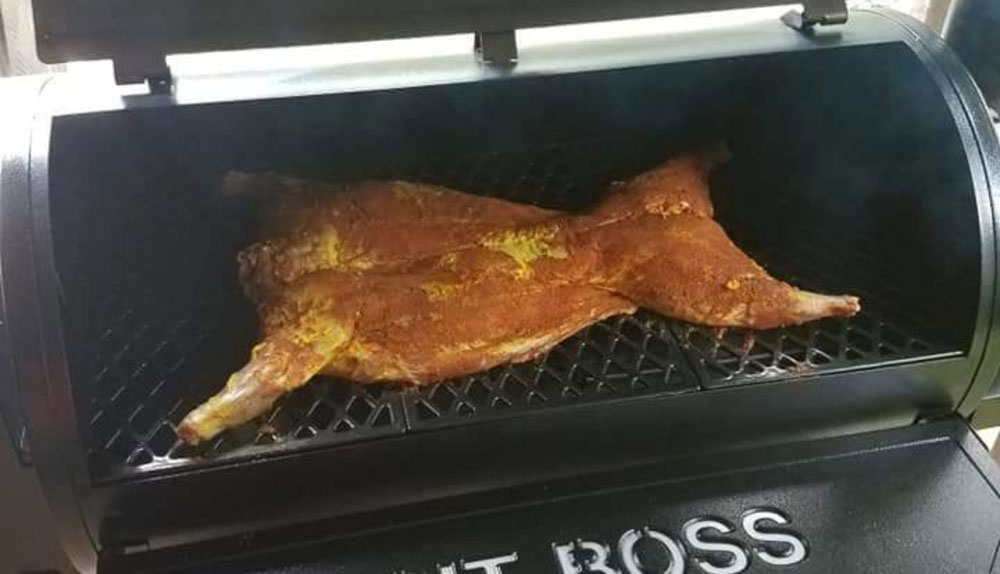
I’m often asked, “What is the best eating-size hog?” I like to eat hogs that will weigh between 80 and 100 pounds. That size hog is really good table fare. Feral hogs probably produce the most organic meat you can eat. They mainly feed on natural food in the wild, they don’t get any steroids or antibiotics shots, and the meat is usually much leaner than the meat you buy in the store. Plus, they taste just like domestic hogs, if you prepare them properly.
When I catch a hog that weighs 40 to 60 pounds, after I field dress and skin it, I’ll put the whole hog on my smoker. I can smoke whole hogs weighing up to 100 pounds. I like to keep the temperature in my smoker at about 200 degrees, and I’ll let that hog cook until I can’t pick the hog up without the meat falling off the bone. I have cut up and smoked a 300-pound hog before. All our family and neighbors usually will come around when I start smoking meat. All that was left after we cooked that big 300-pound hog was about a gallon of meat.
When my smoker starts up, we’ll often have people I don’t even know stop by and get them some of that barbecued, wild hog meat. I had some people pull in the driveway one time when we were smoking some hogs, and when they left, I asked my wife, “Did you know those people?” She answered, “No. I thought you knew them!” We always have plenty of meat to feed folks. Turns out those folks were new to our town and lived on our road that we hadn’t met before. I guess they saw a crowd of folks, stopped to see what was going on and decided to join in on the hog eating.
How to Dress, Cook and Eat a 300-Pound Wild Boar Hog That Tastes Delicious
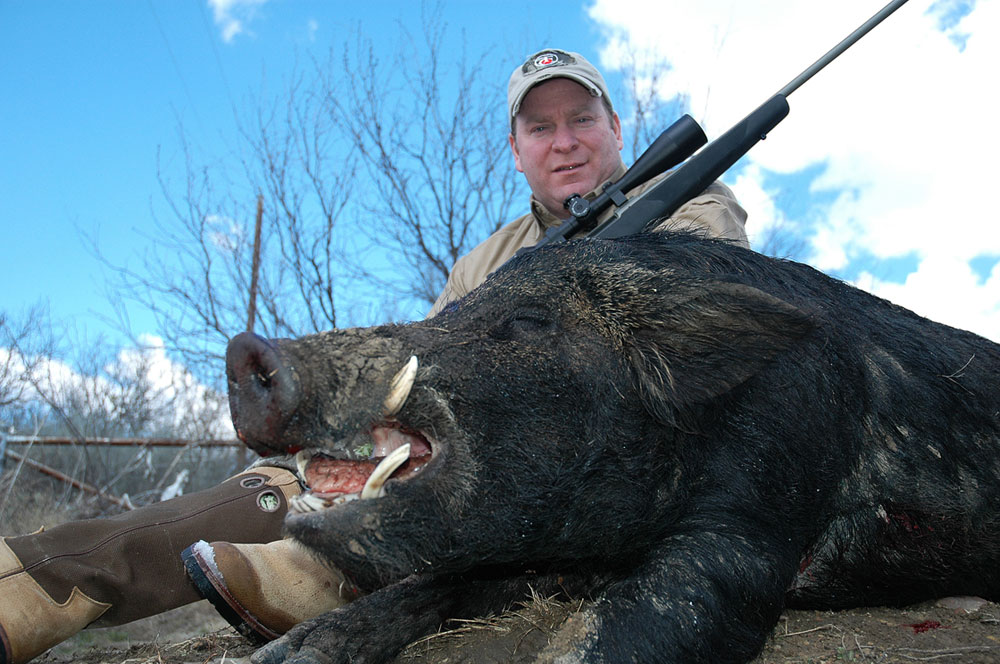
Most people believe that a 200-pound-plus boar hog isn’t any good to eat - and I did too. One time I decided to eat a big boar hog, took it into my kitchen and started cooking it. My wife ran me out of the house because she said that nasty thing was stinking up her whole kitchen, and if I ever did that again, I’d have to find me a new place to live.
Later I met an old wild-hog hunter who told me:
“Most people who take a big boar try to field dress him just like they will a deer. They’ll split him open, pull all his entrails out and then wonder why his meat tastes so terrible. But I’ve learned how to field dress a big boar hog, so that his meat is just as tasty as a young sow. Make a cut about 6-inches above the boar’s penis. Don’t cut through the stomach line. Then make another 6-inch cut on the left-hand side and the right-hand side of the center cut you’ve already made to make a T-shape. Then you skin the boar all the way back to his anus.”
This hunter said there are two glands on either side of the hog’s penis that he called, “Water Sacks.” He explained that if you skin the hog’s belly from 6-inches in front of his penis, and 6- inches on the outside of his penis all the way back to his anus and take the penis and the testicles and those two glands out before you open up the stomach cavity, then you don’t ruin the meat and put that terrible taste into the meat of a big hog.”
I believe those two glands probably are musk glands and must be removed. So, be sure not to cut through the stomach wall of these big boar hogs. Get rid of those hog parts before you cut through the stomach wall and take his entrails out. Then you can skin that hog and cut him up to prepare to eat just like you will cut up any other type of hog. I tried this procedure on a big boar, after my wife had threatened my life if I ever put boar meat in her skillet and stunk up her house again. I tried cooking up some of that boar meat after learning from the old hunter. It did not stink up my wife’s house, and the meat was really delicious.
The biggest hog I’ve ever dressed and eaten this way was a 400-pound boar hog. Actually I ground-up most of that meat and made sausage. It did not have any off-flavor. I make my own sausage and I like a good bit of sage in my sausage. I like sausage that tastes like sausage. The local grocery store here in town makes up a sausage mix. I add that sausage mix to sage and mix that with my sausage meat and it’s delicious. Before I package my wild pig sausage, I patty up some of sausage, fry it in the skillet and taste it to make sure that that batch of sausage is just like how I like it. That’s what I suggest you do if you make sausage out of feral hogs.
How to Cook a Big Boar’s Hams and Feed People
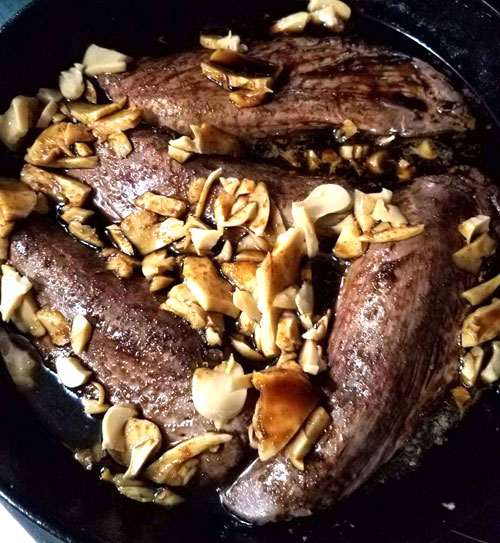
If I take a boar hog that weighs from 200 to 400 pounds, I’ll often take the two hindquarters and rub them with a hickory dry rub. Then I’ll smoke those two hindquarters for about two hours, take them out of the smoker, wrap each hindquarter in tin foil and then put the hindquarters back in the smoker. I’ll cook them at about 200 degrees for several hours. Occasionally, while the meat’s cooking in the tin foil, I’ll open up the tin foil some, stick a fork in that hindquarter to see if it’s tender. If it’s not, I’ll let it cook for another hour or two, until the meat is very tender. Then I’ll take the hindquarters off the smoker and with the tinfoil still in place, I’ll wrap towels around them to keep the heat and juice in them. Next, I’ll put the hindquarters in an empty ice chest for about 30 minutes. That process causes those hams to absorb the juices that have been inside the tin foil. When you take the hindquarters out to eat, that ham will be absolutely delicious.
In the fall of the year, I’ll usually hunt hogs with a rifle, a crossbow, a pistol or a muzzleloader. I look for fresh sign and hunt over fresh wallows. Some hunters will shoot hogs right behind their shoulders like they’ll shoot a deer. However, a big hog has so much fat on him that the entry hole may close up with fat. Then you won’t have a good blood trail. To solve that problem, I try and shoot the wild hogs I take in the ear or right behind the ear. Then, the hog will die in the track where he’s standing.
On my best day of hog hunting, six hogs came into my stand, and I shot four of them with a .306 automatic rifle. One of the hogs weighed 150 pounds, and the other three weighed between 80 to 100 pounds each. They were good, eating-sized hogs.
I’m often asked, “What do you do with all that feral hog meat you take during the year?” I don’t have any trouble getting rid of all of the hogs I take. I have a tree beside my house that I call my skinning tree. When the older people who live around me see my truck backed up to that skinning tree, they’ll stop by, look at my hogs and put their orders in for me. Whatever hogs they want, I clean those hogs, package the meat and take the meat to them. I’ve got at least 15 different families I give wild hog meat to and perhaps more than that. Most of these are older people who love to hunt, but they’ve gotten to the age where they can’t go hunting. So, I feel like we’ve all got to take care of those folks.
I tell any hunter who loves to turkey and deer hunt to kill all the feral hogs you possibly and legally can because those feral hogs destroy turkey nests. If you’ve got good natural food to deer hunt over, or you’ve planted green fields to try and feed your deer and take your deer, feral hogs will move in, run the deer off from the food and eat the deer’s food. Feral hogs are the worst critters in the woods for destroying ground-nesting birds’ nests, like grouse and turkeys, and they out-compete the deer for natural food. When you take hogs, if you’ve got more than you can eat, I’m sure there are folks in your neighborhood who certainly will appreciate the fresh pork that you’ve harvested.






























